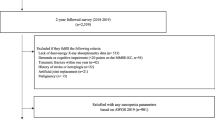Abstract
This study aims to explore whether the current definitions of sarcopenia are applicable to the older Chinese population. Participants were 783 Chinese adults recruited from four regions in Mainland China: Jinan, Guangzhou, Xi’an, and Chengdu. Body composition was measured by dual energy x-ray absorptiometry. Handgrip strength, body weight, and height were measured by trained technicians, and demographic data were collected through questionnaires. Relative appendicular skeletal muscle, skeletal muscle index (SMI=100 × skeletal muscle mass/body mass) and residuals methods were applied to identify sarcopenia. Compared with young adults, no significant decrease was found in the relative appendicular skeletal muscle (ASM/height2) in older adults. If the criterion of two standard deviations below the mean value of ASM/height2 in young adults is used, none of older adults in this study could be diagnosed with sarcopenia. In addition, compared with the ASM/height2 and residuals methods, SMI shows higher discriminating power in the identifying persons with low handgrip strength. The data suggest that ASM/height2 method may not be appropriate for diagnosis of sarcopenia in Chinese population. However, whether SMI is a better choice remains inconclusive. Prospective studies are needed to clearly define sarcopenia in Chinese population.
Similar content being viewed by others
References
Delmonico MJ, Harris TB, Lee JS, Visser M, Nevitt M, Kritchevsky SB, Tylavsky FA, Newman AB, Health Aging and Body Composition Study: Alternative definitions of sarcopenia, lower extremity performance, and functional impairment with aging in older men and women. J Am Geriatr Soc 2007;55:769–774.
Fleg JL, Lakatta EG: Role of muscle loss in the age-associated reduction in vo2 max. J Appl Physiol 1988;65:1147–1151.
Fukagawa NK, Kenney WL, Buskirk ER: Functional consequences of sarcopenia: Effects on thermoregulation. J Gerontol A Biol Sci Med Sci 1995;50A:78–85.
Lauretani F, Russo CR, Bandinelli S, Bartali B, Cavazzini C, Di Iorio A, Corsi AM, Rantanen T, Guralnik JM, Ferrucci L: Age-associated changes in skeletal muscles and their effect on mobility: An operational diagnosis of sarcopenia. J Appl Physiol 2003;95:1851–1860.
Roubenoff R: Sarcopenia: Effects on body composition and function. J Gerontol A Biol Sci Med Sci 2003;58:M1012–M1017.
Janssen I, Shepard DS, Katzmarzyk PT, Roubenoff R: The healthcare costs of sarcopenia in the united states. J Am Geriatr Soc 2004;52:80–85.
Cruz-Jentoft AJ, Baeyens JP, Bauer JM, Boirie Y, Cederholm T, Landi F, Martin FC, Michel JP, Rolland Y, Schneider SM, Topinková E, Vandewoude M, Zamboni M: Sarcopenia: European consensus on definition and diagnosis. Report of the european working group on sarcopenia in older people. Age Ageing 2010;39:412–423.
Baumgartner RN, Koehler KM, Gallagher D, Romero L, Heymsfield SB, Ross RR, Garry PJ, Lindeman RD: Epidemiology of sarcopenia among the elderly in new mexico. Am J Epidemiol 1998;147:755–763.
Lau EMC, Lynn HSH, Woo JW, Kwok TCY, Melton LJI: Prevalence of and risk factors for sarcopenia in elderly chinese men and women. J Gerontol A Biol Sci Med Sci 2005;60:213–216.
Lee JSW, Auyeung TW, Kwok T, Lau EMC, Leung PC, Woo J: Associated factors and health impact of sarcopenia in older chinese men and women: A cross-sectional study. Gerontology 2007;53:404–410.
Woo J, Leung J, Sham A, Kwok T: Defining sarcopenia in terms of risk of physical limitations: A 5-year follow-up study of 3,153 chinese men and women. J Am Geriatr Soc 2009;57:2224–2231.
Janssen I, Heymsfield SB, Ross R: Low relative skeletal muscle mass (sarcopenia) in older persons is associated with functional impairment and physical disability. J Am Geriatr Soc 2002;50:889–896.
Newman AB, Kupelian V, Visser M, Simonsick E, Goodpaster B, Nevitt M, Kritchevsky SB, Tylavsky FA, Rubin SM, Harris TB, Health ABC Study Investigators: Sarcopenia: Alternative definitions and associations with lower extremity function. J Am Geriatr Soc 2003;51:1602–1609.
Ellis K: Body composition of a young, multiethnic, male population. Am J Clin Nutr 1997;66:1323–1331.
Ellis K, Abrams S, Wong W: Body composition of a young, multiethnic female population. Am J Clin Nutr 1997;65:724–731.
Mott JW, Wang J, Thornton JC, Allison DB, Heymsfield SB, Pierson RN, Jr: Relation between body fat and age in 4 ethnic groups. Am J Clin Nutr 1999;69:1007–1013.
Salamone LM, Fuerst T, Visser M, Kern M, Lang T, Dockrell M, Cauley JA, Nevitt M, Tylavsky F, Lohman TG: Measurement of fat mass using dexa: A validation study in elderly adults. J Appl Physiol 2000;89:345–352.
van der Ploeg GE, Withers RT, Laforgia J: Percent body fat via dexa: Comparison with a four-compartment model. J Appl Physiol 2003;94:499–506.
Fried LP, Tangen CM, Walston J, Newman AB, Hirsch C, Gottdiener J, Seeman T, Tracy R, Kop WJ, Burke G, McBurnie MA: Frailty in older adults: Evidence for a phenotype. J Gerontol A Biol Sci Med Sci 2001;56:M146–M157.
Chien MY, Huang TY, Wu YT: Prevalence of sarcopenia estimated using a bioelectrical impedance analysis prediction equation in community-dwelling elderly people in taiwan. J Am Geriatr Soc 2008;56:1710–1715.
Janssen I, Baumgartner RN, Ross R, Rosenberg IH, Roubenoff R: Skeletal muscle cutpoints associated with elevated physical disability risk in older men and women Am J Epidemiol 2004;159:413–421
Author information
Authors and Affiliations
Corresponding author
Rights and permissions
About this article
Cite this article
Wen, X., Wang, M., Jiang, C.M. et al. Are current definitions of sarcopenia applicable for older Chinese adults?. J Nutr Health Aging 15, 847–851 (2011). https://doi.org/10.1007/s12603-011-0088-3
Received:
Accepted:
Published:
Issue Date:
DOI: https://doi.org/10.1007/s12603-011-0088-3




